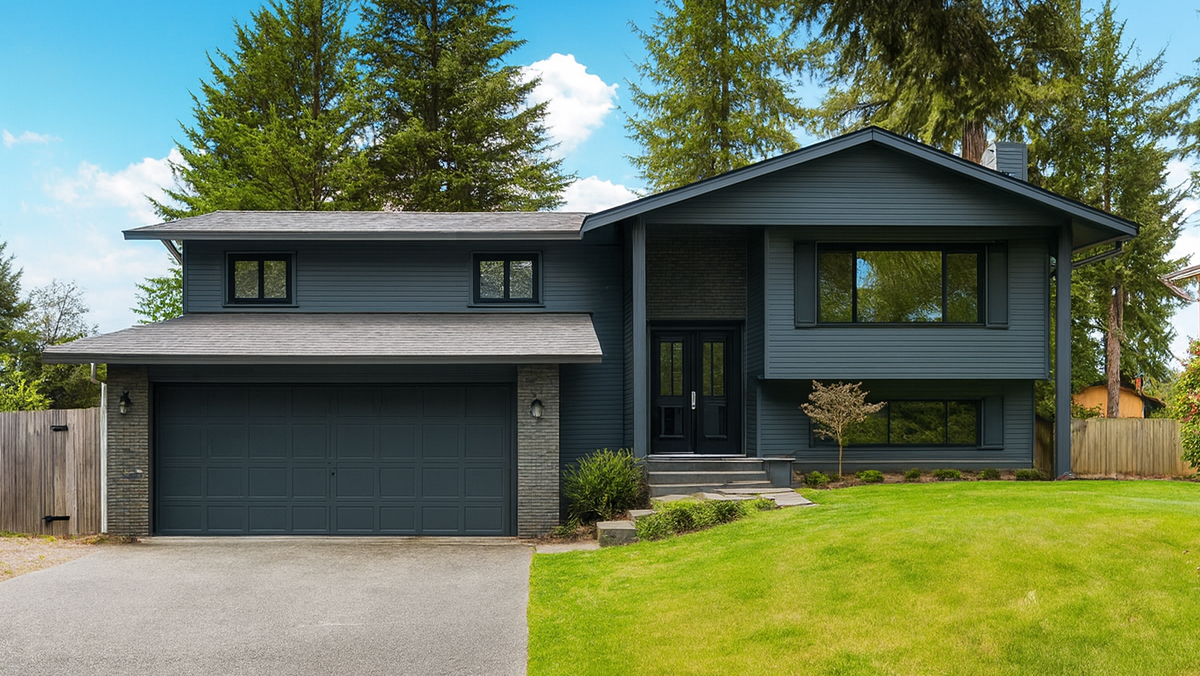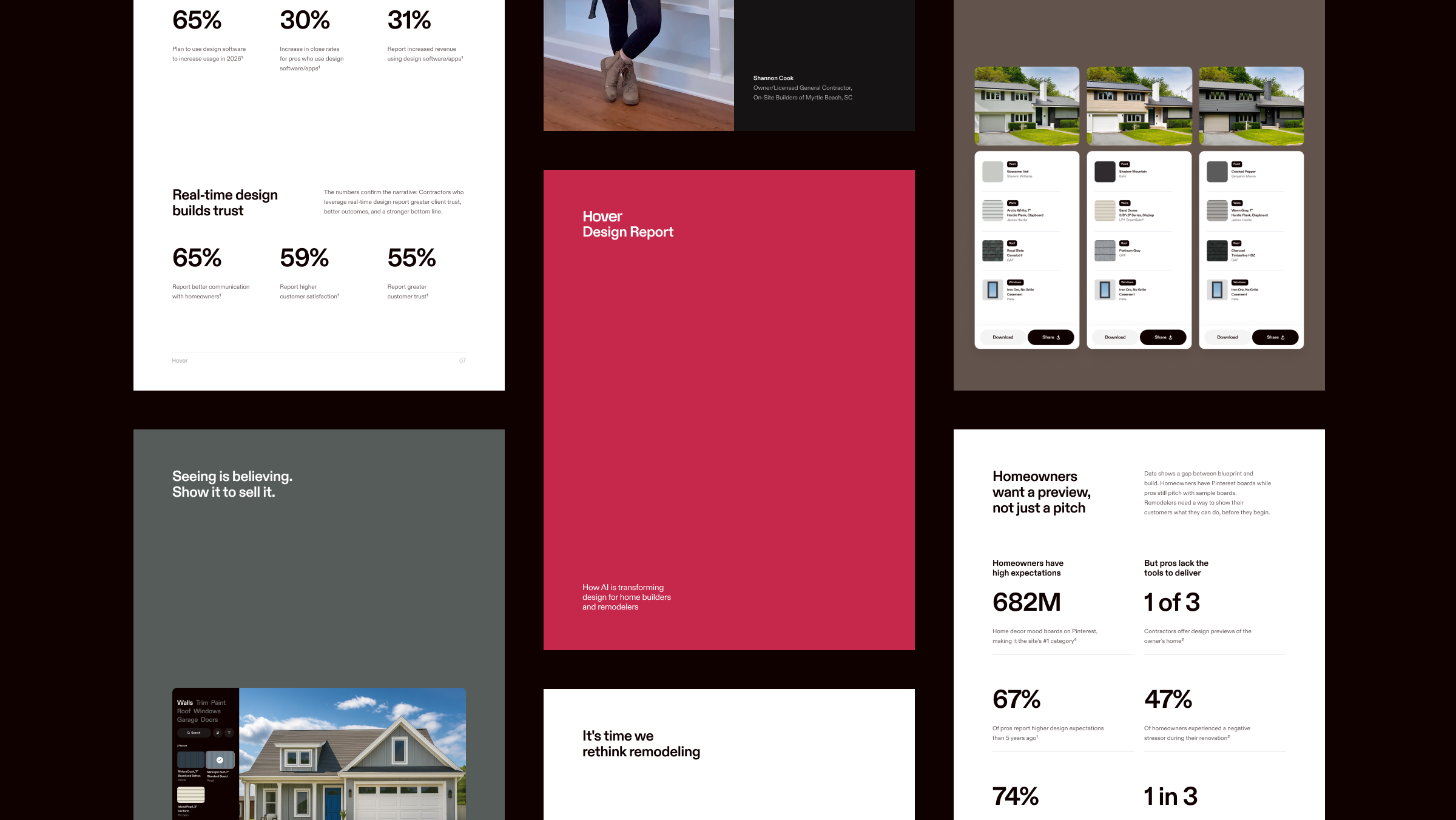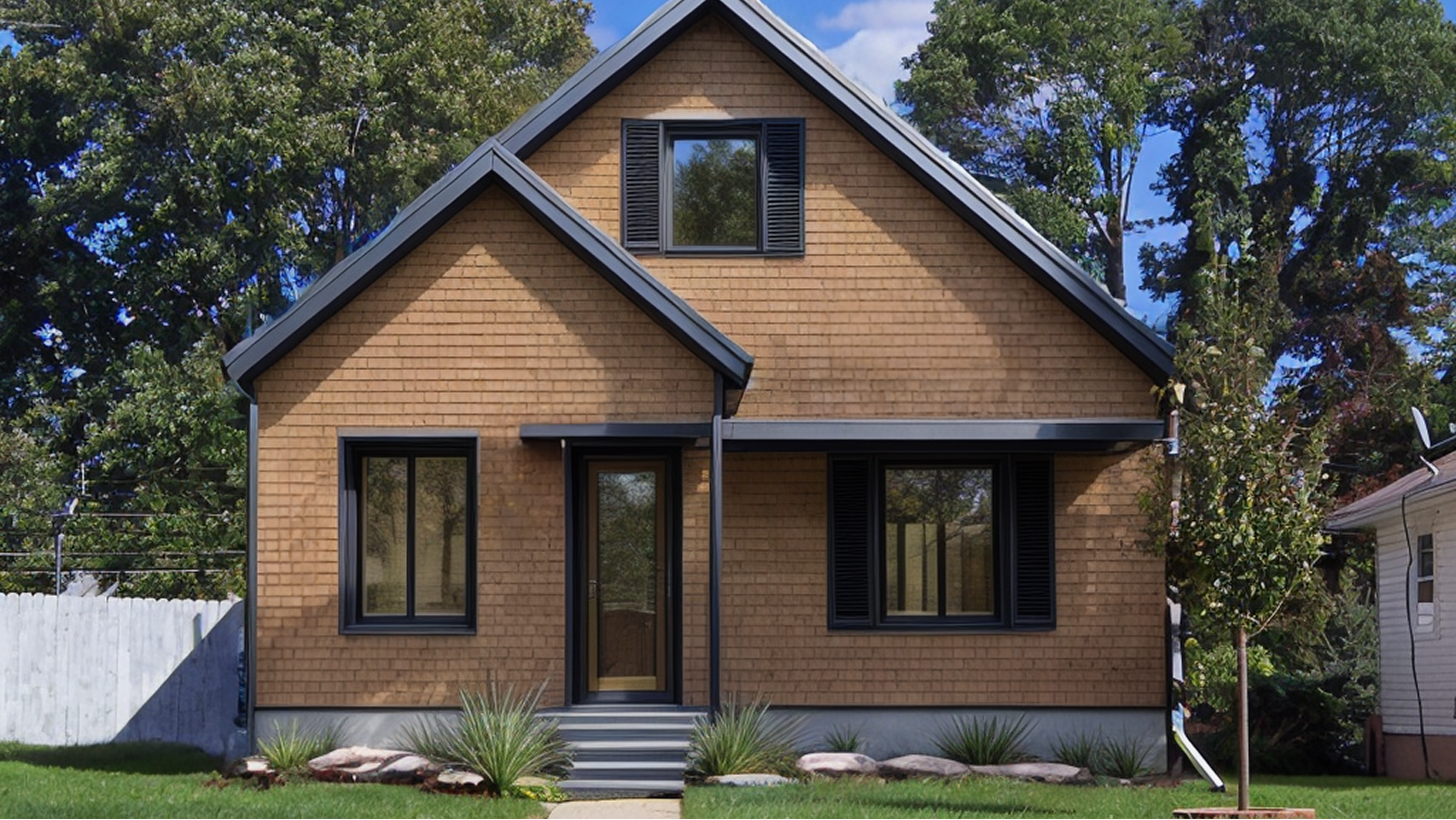In 2026, design is getting tactile and going natural. But your job isn't just knowing the trends, it’s helping your customers visualize them in their own home, before they commit.
With Hover Instant Design, you don’t have to tell them what’s coming, you can show it. Combine your knowledge of the leading 2026 design trends with Hover’s real-time visualization, and you can bring the future of home design right to their kitchen table.
That’s how pros will close more deals in 2026: by turning design forecasts into remodels they’ll love.
Trend #1: Palettes they need to feel
Forget sterile minimalism. Next year’s color story is all about depth, texture and connection.
- Deep Indigo – Reflects digital balance and sophistication
- Moss Green – A nod to nature, calm and sustainability
- Burnt Saffron – Adds warmth, optimism, and organic energy
- Warm Beige & Greige – Cozy, flexible neutrals replacing sterile whites
- Terra Firma: Warm taupes, clay, and terracotta that deliver curated comfort
These palettes — seen across reports from Pantone, Sherwin-Williams, and design week trend houses — tap into homeowners’ desire for comfort and calm.
Instead of describing how moss Green siding pairs beautifully with stone, open Hover Instant Design and show them. Let your clients see the contrast, warmth, and modern organic style on their home exterior and embrace the transformation.
Use this quick guide to help your customers explore the latest colors on their home’s exterior:
|
Palette |
Works well for |
Pair with |
|
Deep Indigo |
Front doors, shutters, accent panels |
Warm wood tones, brushed brass |
|
Moss Green |
Siding, trim-body combos |
Natural stone, black windows |
|
Burnt Saffron |
Entry accents, shutters |
Greige body, off-white trim |
|
Warm Beige/Greige |
Full body or trim |
Charcoal roof, wood accents |
|
Terra Firma |
Accent cladding, porch ceilings |
Bronze metals, limewash brick |
Trend #2: Selling the "Un-Kitchen" and the bathroom spa sanctuary
Design trends in 2026 go beyond aesthetics and focus on how a space makes you feel. There’s a shift to modern organic, blending clean modern lines with natural, tactile materials like unfinished wood, stone walls, and exposed beams. Instead of new builds, there’s a renewed interest in renovating existing structures with sustainable materials to preserve architectural character while updating functionality.
These styles translate into fresh concepts for familiar spaces:
- “Un-Kitchens” – streamlined spaces that integrate with the rest of the home, featuring concealed prep and mess functionality and seamless flow.
- Spa-inspired bathrooms that double as daily retreats, with wet rooms and natural light.
- Biophilic home offices that look as good as they feel, with soundproofing and circadian lighting. Not just a space to do work, but to feel better about work.
With Hover Instant Design, you can show the same kitchen with and without concealed prep zones, or help them visualize how a wet-room bathroom layout opens up the space. You’re not asking them to take your word for it. You’re showing them what’s possible.
Un-Kitchens: What are they?
Trending for 2026, an “Un-Kitchen” visually blends with living spaces by concealing appliances, storage, and prep zones behind integrated panels. The effect is a calm, furniture-like room that functions as a kitchen without looking like one.
What’s the difference between an Un-Kitchen vs. a minimalist kitchen?
|
Aspect |
Un-Kitchen |
Minimalist kitchen |
|
Visual goal |
Disappears into the living space |
Clean lines, still “reads” as a kitchen |
|
Storage |
Concealed, furniture-like |
Streamlined, visible cabinetry |
|
Appliances |
Paneled/integrated |
Sleek finishes, typically visible |
|
Lifestyle fit |
Open plans, multi-use spaces |
Design-forward but kitchen-centric |
Wet rooms: Pros and cons
A wet room is a fully waterproofed bathroom with a level-entry shower and a continuous floor plane for an open, low-threshold layout.
|
Pros |
Cons |
|
Open, spa-like feel |
Requires meticulous waterproofing |
|
Accessible, low threshold |
Potential for more humidity—ventilation matters |
|
Clean lines |
Slip resistance must be specified |
|
Great for compact spaces |
Drainage slope affects tile selection |
What’s a biophilic office?
Biophilic refers to something that’s ecocentric and nature-based. For the home office, that translates to a room with:
- Natural materials and textures
- Daylight and views; consider light shelves
- Acoustic treatment and sound isolation
- Plants/green elements; circadian lighting presets
Trend #3: The new facade: natural durability
Homeowners want their exterior to look as good as it lasts. Materials innovations, evolving codes, and demand for low-maintenance, high-performance materials are changing what’s possible. Home exteriors can now offer greater durability, sustainability, and connection to the environment.
For 2026, customers can swap traditional wood or metal cladding for high-performance wood alternatives like fiber cement, engineered wood, and fire-resistant panel systems. Earthy hues like charcoal, rich bronze, and moss green connect homes to their natural environment. Top it off with a roof that’s functional—either with integrated solar tiles or a living/green roof—and the modern organic look is complete.
By showcasing high-performance, durable facades, you showcase design that truly lasts. Trends like warm woods and modern organic let materials stand on their own, with stone walls, unfinished wood accents, and low-maintenance siding. Use visualization to prove the long-term value and aesthetic integrity of these investments.
Pro tip: Use Instant Design to help your customer visualize a wood-look, fiber-cement exterior versus natural wood and compare the maintenance and lifespan of each option. Then do the same for the roof.
Siding materials: Looks-like-wood options
|
Material |
Looks like |
Maintenance |
Typical lifespan |
Fire/code notes |
|
Fiber-cement siding |
Painted/natural wood |
Low |
30–50 yrs |
Non-combustible; WUI-friendly |
|
Engineered wood siding |
Real wood |
Low–Medium |
20–30 yrs |
Factory finishes; check warranty |
|
Natural wood |
Real wood |
Medium–High |
15–25 yrs |
Requires finishing; ember exposure risk |
Living roof vs. solar tiles
|
Feature |
Living/green Roof |
Solar tiles |
|
Primary benefit |
Stormwater + insulation + biophilia |
On-site power generation |
|
Structural needs |
Added load + waterproofing |
Roof orientation + electrical |
|
Maintenance |
Seasonal plant care |
Occasional cleaning/monitoring |
|
Best fit |
Urban heat islands/eco goals |
High-sun regions/incentives |
How to close more in 2026
By showing (not telling) the potential of 2026 trends, you can move your customers towards a longer-lasting remodel and higher price tag, without the buyer’s remorse.
Here’s how to use Hover Instant Design and put the trends to work:
- Snap some photos of the property
- Visualize 2–3 options in Hover Instant Design (palette + layout/material).
- Present side-by-side renders (or via shared link).
- Price the winning direction and alternatives with Estimates & Proposals.
- Close with a clear scope and timeline.
FAQs
What is an un-kitchen?
An un-kitchen blends into adjacent living spaces by hiding appliances and storage behind integrated panels, creating a calm, furniture-like room.
Is a wet-room bathroom practical for families?
Yes—when properly waterproofed and ventilated. Specify slip-resistant tile and plan for sufficient storage to keep it tidy.
Which exterior materials look like wood but are low-maintenance?
Fiber-cement and engineered wood mimic the look of real wood with lower upkeep, greater durability, and longer lifespans.
How can I show clients design options before they buy?
Use Hover Instant Design to generate side-by-side visualizations of colors, materials, and layouts on their home.
What colors are trending for home exteriors in 2026?
Earthy, comforting hues such as Moss Green, Warm Greige, and charcoal accents—often paired with natural textures and bronze/black metals.


-1.jpg)
